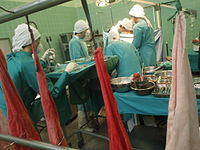
Photo from wikipedia
Dear Editor, Acquisition of microsurgical skill requires considerable practice and has a steep learning curve. The advent of supermicrosurgery and its increasing utilization in lymphatic surgery introduces further skills in… Click to show full abstract
Dear Editor, Acquisition of microsurgical skill requires considerable practice and has a steep learning curve. The advent of supermicrosurgery and its increasing utilization in lymphatic surgery introduces further skills in handling and anastomosis of ultra-fine neurovascular tissue. While live rat anastomosis remains the standard microsurgery training model, rising costs and ethical concerns have led to the development of a variety of non-living synthetic and animal models that offer the advantages of low cost and easy availability (Rodriguez, Yañez, Cifuentes, Varas, & Dagnino, 2016). Pigs have widely been used in surgical training and research as they provide a large animal with tissue structure that bears close resemblance to that of humans (Ito & Suami, 2015). Pig skin is regarded as equivalent to human skin with similar size, orientation and distribution of vessels making it most suitable for lymphatic research as well as microsurgical training (Ito & Suami, 2015; Suami & Schaverien, 2016). Suami and Schaverien developed a supermicrosurgical training model using the pig hind limb from the hip joint to digits, however, despite its recognition of high-fidelity, this method was criticized for being expensive and inconvenient, limiting its widespread use (Pafitanis, Narushima, Yamamoto, et al., 2018; Suami & Schaverien, 2016). We present a simplified supermicrosurgical training method using only the pig foot and readily available dyes to practice lymphaticovenular anastomosis (LVA). Pork trotters (pig feet) from the local supermarket are thawed. Using a 1 ml syringe, 0.05 ml indocyanine green or blue dye (methylene blue or gentian violet) is injected subdermal between the digits, and the limb is gently massaged. Lymphatic mapping is then performed using a nearinfrared camera, if available, and LVA sites marked (Figure 1a,b). A skin incision is made, and the lymphatics and venules identified following
Journal Title: Microsurgery
Year Published: 2019
Link to full text (if available)
Share on Social Media: Sign Up to like & get
recommendations!